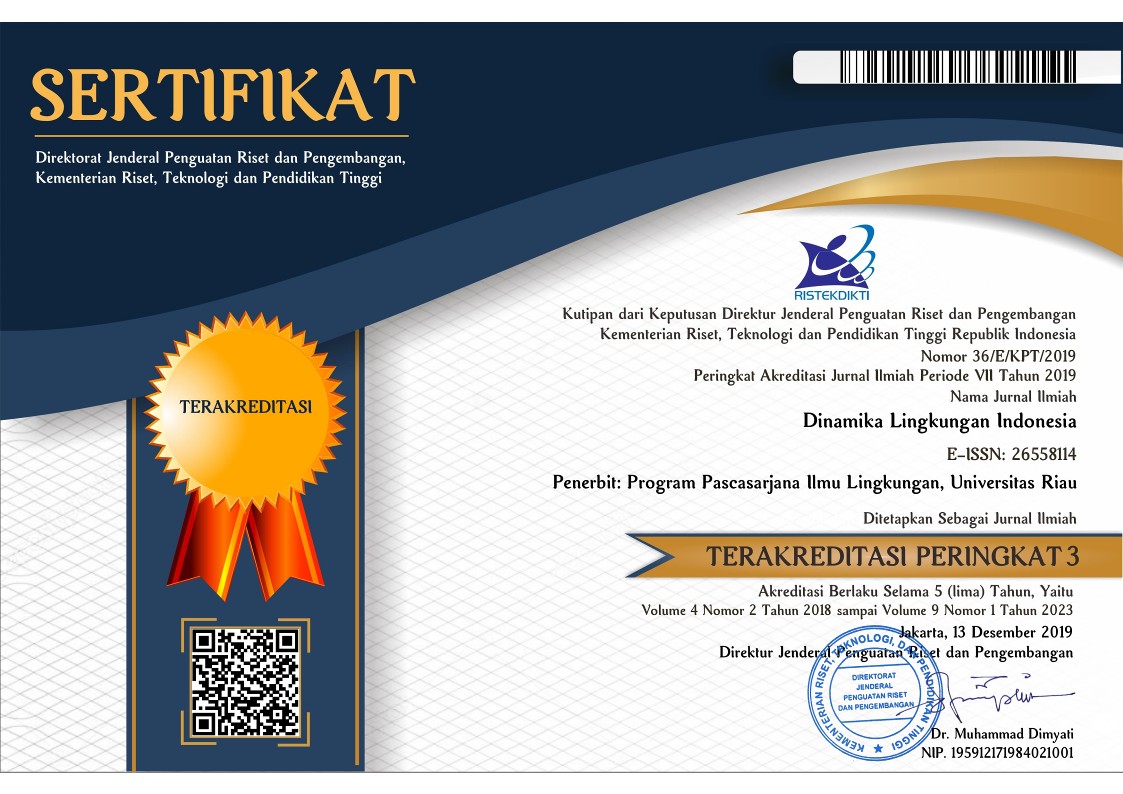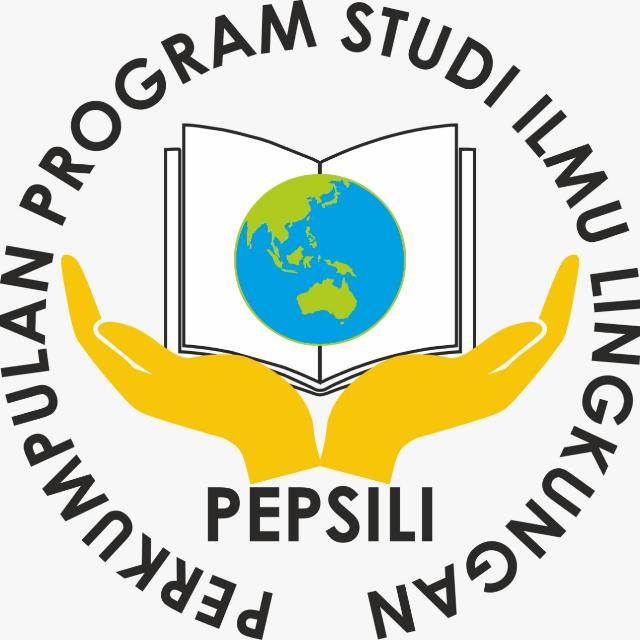Analisis Histopatologis Insang dan Kandungan Logam Berat Pb, Cd dan Fe Pada Ikan Nila (Oreochromis Niloticus) yang Dibudidayakan di Kolam Bekas Tambang Kota Samarinda
Abstract
Coal mining activities openly cause the formation of mine pits and are currently used by the community for fish farming. This research aims to determine the histopathological status of gills, heavy metal content (Pb, Cd, and Fe) in tilapia fish (Oreochromis niloticus) and water bodies ponds. Samples were taken by purposive sampling technique at four locations with different ages, namely Senong Pit (5 years), Goldstar Pit (10 years), Bendang Galactic Pit (15 years) and Control. Measuring heavy metal content was carried out using AAS. Fish gills are processed by the paraffin method and hematoxylin-eosin staining. The results of the analysis of the heavy metal content of Pb, Cd, and Fe in surface water in all ponds are below the Class II Water quality standard based on the Provincial Regulation of East Kalimantan No. 02 of 2011. The value of heavy metal concentrations in sediments is higher than in water. Pb content in Tilapia (Oreochromis niloticus) meat from all ponds is between 2.92 to 4.41 mg / kg, while Cd is between 0.02 to 0.03 mg / kg. The Pb metal content status of the results of this study is above the limit of heavy metal contamination determined by BPOM Decree No. 5 of 2018 which is 0.02 mg / kg, while the heavy metal Cd is still below the specified limit of 0.10mg / kg.The total content of Fe metal ions in fish meat is 83.64 up to 144.92 mg/kg bw These results indicate the total content of Fe ions is far above the safe limit standard for the presence of Fe contaminants in all food sources based on FAO / WHO (2011) of 0.8 mg/kg. Fish originating from all post-mining pond ages indicate damage to the histological structure gills which are characterized by damage to epithelial cells, changes in secondary lamella structures characterized by hyperplasia, destruction of secondary lamella structures and filaments, lamella aneurism and secondary lamella fusion. The results showed that histopathologically and bioaccumulation of heavy metals in fish meat from post-mining ponds showed unhealthy conditions.
Keywords
Full Text:
PDFReferences
Andreji,J.,Ivan,S.,Peter,M.,and Miroslav, .2006. Accumulation of Some Metals in Muscles of Five Fish Species from Lower Nitra River Journal of Environmental Science and Health Part A, 41:2607–2622, 2006.
Authman MMN, Zaki MS, Khallaf EA, Abbas HH.2015. Use of Fish as Bio-indicator of the Effects of Heavy Metals Pollution. J Aquac Res Development 6: 328.
Antonio FF, Jorge V, Ferreira C, Sofia GS, Sandra MM, JoaoC, Pedro M, Antonio FF. 2007. Histopathological changes in liver and gill epithelium of nila tilapia (oreochromis niloticus) exposed to waterbone copper. Pesq Vet Bras 27(3):25-30.
El-Sikaily, Saad, Kassem.2016.Metallothionein and Glutathione Content as Biomarkers of Metal Pollution in Mussels and Local Fishermen in Abu Qir Bay, Egypt. J Health Pollution 12: 50-60.
Evans DH. The fish gill: site of action and model for toxic effects of environmental pollutants. Environ Health Perspect. 1987;71:47-58.
FAO/WHO 2011.Joint FAO/WHO food standards programme codex committee on contaminants in foods, March 2011. p 87.
Hafids R, Pagoray H dan Udayana D. 2015. Kandungan Logam Berat Fe dan Mn pada Ikan yang dibudidayakan di Kolam Pasca Tambang Batubara Kabupaten Kutai Kartanegara Kalimantan Timur. Jurnal Ilmu Perikanan Tropis. Vol. 21. No. 1, Oktober 2015:061–067.
Idriss AA, Ahmad AK.2015. Heavy metal concentrations in fishes from Juru River, estimation of the health risk. Bull. Environ. Contam.Toxicol., 94:204-208.
Jasim BM.,2017. Impact of Certain Heavy Metals on Histology and Physiology of Fishes: Interpretative Study. Annual Research & Review in Biology 19(6): 1-21.
Lopes,F,F and Thomaz,A.T.2011. Histopatho logic alterations observed in fish gills as a tool in environmental monitoring. Braz. J. Biol., 2011, vol. 71, no. 1, p. 179-188.
Badan Pengawas Obat dan Makanan. 2018.Peraturan Badan Pengawas Obat dan Makanan Nomor 5 Tahun 2018 Tentang Batas Maksimum Batas Maksimum Cemaran Logam Berat dalam Pangan Olahan.
Palar, H. 2008. Pencemaran dan Toksikologi Logam Berat. Jakarta : Rineka Cipta.
Perry SF, Laurent P.1993. Environmental effects on fish gill structure and function. In: Rankim JC,Jensen FB,editors.Fish Ecophysiology London,UK:Chapman and Hall, pp.231-264.
Polat F, Akın Ş, Yıldırım A, Dal T.2015. The effects of point pollutants originated heavy metals (lead, copper, iron, and cadmium) on fish living inYeşilırmak River, Turkey. Toxicol. Ind. Health, 1-12. Toxicol Ind Health January 9.
Ravanaiah G, Narasimha Murthy CV (2010) Impact of aquaculture and industrial pollutants of Nellore district on the histopathological changes in the gill of fish, Tilapia mossambica. Indian J Comp Anim Phsiol 28:108–114.
Roy, S.P. 2010. “Overview of Heavy Metals and Aquatic Environment with Notes on Their Recovery.” Ecoscan: An International Quarterly Journal of Environmental Sciences 4: 235–240.
Satarug S, Baker JR, Urbenjapol S, Haswellelkins M, Reilly P.E, Williams D.J, et al. A global perspective on cadmium pollution and toxicity in non-occupationally exposed population. Toxicol. Lett. 2003; 137(1), 65–83.
Sorensen, EM. 1991. Metal Poisoning in Fish. Boca Raton, FL: CRC.
Suntoro SH.1983. Metode Pewarnaan, Histologi dan Histokimia. Bhratara Karya Aksara. Jakarta.
Valavanidis A, Vlahogianni T, Dassenakis M, and Scoullos M. 2006. “Molecular Biomarkers of Oxidative Stress in Aquatic Organisms in Relation to Toxic EnvironmentalPollutants.”Ecotoxicology and Environmental Safety 64: 178–189.
Wahyuni H,Sasongko S.B, Sasongko DP.2013.Kandungan Logam Berat pada Air, Sedimen dan Plankton di Daerah Penambangan Masyarakat Desa Batu Belubang Kabupaten Bangka Tengah.Prosiding Seminar Nasional Pengelolaan Sumberdaya Alam dan Lingkungan: 489-494.
Wei, W., Rui, M., Ziyong,S, Aiguo., Z, Jianwei B., Xiang, L and Yunde,L.,2018. Effects of Mining Activities on the Release of Heavy Metals (HMs) in a Typical Mountain Headwater Region, the Qinghai-Tibet Plateau in China. Int. J. Environ. Res. Public Health 2018, 15, 1987.
Wood, C.M.,2001. Toxic responses of the gill, In: Target Organ Toxicity in Marine and Freshwater Teleosts Organs, Eds., Schlenk, D. and W.H. Benson vol. 1.Taylor & Francis, London, 1-89 .
DOI: http://dx.doi.org/10.31258/dli.7.1.p.36-42
Refbacks
- There are currently no refbacks.





